TechRadar Verdict
The iMac 24-inch (M3), is now the best all-in-one computer you can buy. There’s no new design, but it remains a bright, colorful and attractive machine that’ll look great in any home or office, though the 24-inch screen is feeling a little cramped these days. Performance is excellent, and if you’re upgrading from an older iMac, or coming over from Windows, there’s a huge amount to like about this new version. We want to see Apple be bolder with the next model, however.
Pros
- +
New M3 chip offers excellent performance
- +
Still thin and light
- +
Remains the best all-in-one computer
Cons
- -
Design remains the same – including peripherals
- -
Magic Mouse’s charging port is still on the bottom
- -
256GB SSD in base model too small
Why you can trust TechRadar
Apple iMac 24-inch (M3): Two-minute review
Let’s be honest: the title of the best all-in-one computer is the Apple iMac (M3)’s to lose. No Windows-based all-in-one comes close to Apple’s iconic product – and that’s not always a good thing. In the past, it’s led to a sense that Apple is resting on its laurels a bit; there was a period of time in the late 2010s where Apple seemed to pump out Intel-based iMacs with seemingly little to no enthusiasm, just a slight specs bump and the same, increasingly dated, design.
That changed with the launch of the iMac 24-inch (M1, 2021), which not only featured Apple’s new (at the time) M1 chip – the first non-mobile chip the company had produced – but also an overhauled design that slimmed the bezels down, modernized the look and added some much-needed color options. It was easily one of the best redesigns we’ve seen recently, and firmly cemented the iMac as the best all-in-one computer And then… nothing.
When Apple launched the M2 chip, there was no iMac refresh, even though other products, including the Mac mini, got the new SoC. Nor was there any sign of a 27-inch iMac or iMac Pro – both of which have currently never had Apple silicon versions.
It seemed like Apple had fallen out of love with the iMac once again. That was until its ‘Scary Fast’ event on October 30, 2023, where it finally unveiled a new 24-inch iMac (M3), featuring its cutting-edge M3 chip, but keeping pretty much everything else the same as the one from two years ago.

Design-wise, the iMac 24-inch (M3) is identical to the M1 model from two years ago. It remains a great looking device with bright color options – a rarity both for modern Macs and Windows-based PCs – that don’t look childish, but that add a splash of individuality to the all-in-one. The screen remains the same as well, and is bright, sharp and offers excellent color accuracy with the P3 gamut.
However, sticking to the same design also brings back some old frustrations, such as the charging port on the bottom of the Magic Mouse, which means you can’t use it while it’s charging, plus a reliance on the increasingly obsolete Lightning connection for charging all of the peripherals, rather than getting with the times and using USB-C. And there's the lack of larger screen options; this is perhaps the most disappointing aspect of the new model, as 24 inches no longer feels that large, especially for power users who like to work on multiple apps and windows at once.
On the inside, things are much more different, however, with support for Apple’s impressive M3 chip, which offers a noticeable performance increase over the previous M1-powered iMac, and does an excellent job with intensive tasks such as coding and video rendering. It can even play modern games, and while you’re not getting the kind of frames per second seasoned PC gamers expect from their rigs, it’s a promising sign that gaming on Macs may one day no longer be the joke it once was.
Sign up for breaking news, reviews, opinion, top tech deals, and more.

One thing I’d have liked them to keep the same, however, is the price. Unfortunately, the new iMac 24-inch (M3) now starts at $1,399 / £1,399 / AU$2,199, a leap over the starting price of the previous model. In some ways this is understandable – the M3 chip represents a big upgrade in performance, and what isn’t getting more expensive these days? Still, Apple was developing a habit of launching new models for the same price as the previous one, so it’s a shame that has not happened here.
Also, the base model comes with just 8GB of memory and 256GB SSD, which is pretty low these days, and because the iMac isn’t upgradable (this is an Apple product, after all), I’d recommend upping the memory and SSD to future proof your purchase – but that, of course, raises the price further. The new iMac remains the best all-in-one computer you can buy, but it doesn’t feel as good value as the previous model. Make sure you also check out our MacBook Pro 14-inch (M3 Max) review, and MacBook Pro 16-inch (M3 Max) review for our verdicts on Apple's other new Macs.
Apple iMac 24-inch (M3) review: Price and availability
- How much does it cost? Starts at $1,399 / £1,399 / AU$2,199
- When is it available? Available now
- Where can you get it? Available in the US, UK, and Australia
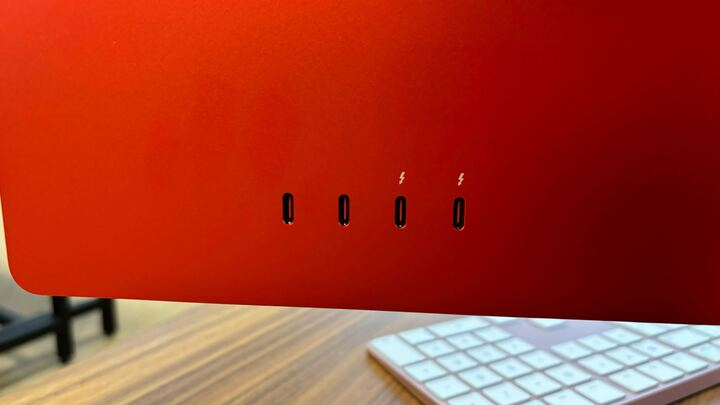
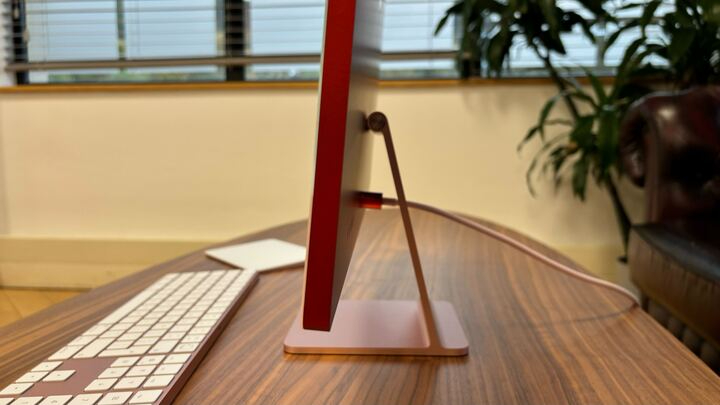

Though Apple launched several MacBook Pros with a range of screen sizes and configuration options (including powerful M3 Pro and M3 Max chips), the new Apple iMac (M3) comes in just one size, 24 inches, and you only get the M3 chip – though that can be configured.
The base model of the Apple iMac 24-inch (M3) starts at $1,399 / £1,399 / AU$2,199, which gets you an M3 chip with 8-core GPU, 8-core CPU, 8GB of memory, 256GB SSD and Magic Keyboard and Magic Mouse.
This is a step up in starting price from the previous M1 model, which launched at $1,299 / £1,249 / AU$1,899, and puts it at the pricier end of all-in-ones. However, Apple is making some big claims about the performance of the M3 chip (which we’ll get to in a bit), so the pressure is on to prove that this price bump is worth it.
You can also buy the new iMac with a slightly more powerful M3 chip with 10-core GPU (and same 8-core CPU, 8GB of memory and 256GB SSD) for $1,499 / £1,599 / $2,499, and this model comes with two additional USB 3 ports, support for Gigabit Ethernet, and Touch ID on the Magic Keyboard to allow you to log in with your fingerprint.
You can configure the base models to come with either 16GB or 24GB of unified memory, which ups the overall price, but which is probably worth doing if you want the iMac for more intensive tasks. That's because, unsurprisingly, you can’t open up the iMac and upgrade the memory later, and 8GB is a bit low these days, especially as with unified memory, you’re sharing it as both standard system RAM and video RAM for the GPU.
You can also configure the iMac 24-inch (M3) for more SSD storage, up to 2TB, and again this is an upgrade I’d recommend you make before you buy, as 256GB will fill up fast, especially if you work with video and photo files. At least you can always add more storage with an external hard drive later on, however.
- Price score: 3/ 5
Apple iMac 24-inch (M3) review: Specs
| iMac M3 8-core GPU | iMac M3 10-core GPU | iMac M3 512GB | |
|---|---|---|---|
| Price: | $1,399 / £1,399 / AU$2,199 | $1,499 / £1,599 / $2,499 | $1,699 / £1,799 / AU$2,799 |
| CPU: | Apple M3 (8-core) | Apple M3 (8-core) | Apple M3 (8-core) |
| Graphics: | Integrated 8-core GPU | Integrated 10-core GPU | Integrated 10-core GPU |
| RAM: | 8GB unified memory | 8GB unified memory | 8GB unified memory |
| Screen: | 24-inch, 4.5K 4,480 x 2,520 Retina display (IPS, 500 nits brightness, wide color P3 gamut) | 24-inch, 4.5K 4,480 x 2,520 Retina display (IPS, 500 nits brightness, wide color P3 gamut) | 24-inch, 4.5K 4,480 x 2,520 Retina display (IPS, 500 nits brightness, wide color P3 gamut) |
| Storage: | 256GB SSD | 256GB SSD | 512GB SSD |
| Ports: | 2x Thunderbolt USB 4 (USB-C), 3.5mm headphone jack | 2x Thunderbolt USB 4 (USB-C), 2x USB 3 (USB-C), 3.5mm headphone jack | 2x Thunderbolt USB 4 (USB-C), 2x USB 3 (USB-C), 3.5mm headphone jack |
| Wireless: | Wi-Fi 6e (802.11ax), Bluetooth 5.3 | Wi-Fi 6e (802.11ax), Bluetooth 5.3 | Wi-Fi 6e (802.11ax), Bluetooth 5.3 |
| Camera: | 1080p FaceTime HD webcam | 1080p FaceTime HD webcam | 1080p FaceTime HD webcam |
| Weight: | 9.88 llbs (4.48kg) | 9.88 llbs (4.48kg) | 9.88 llbs (4.48kg) |
| Dimensions: | 18.1 x 21.5 x 5.8 inches (46.1 x 54.7 x 14.7cm; W x D x H) | 18.1 x 21.5 x 5.8 inches (46.1 x 54.7 x 14.7cm; W x D x H) | 18.1 x 21.5 x 5.8 inches (46.1 x 54.7 x 14.7cm; W |
Apple iMac 24-inch (M3) review: Design
- Same design as M1 model
- Seven color choices
- Peripherals still use Lightning cables


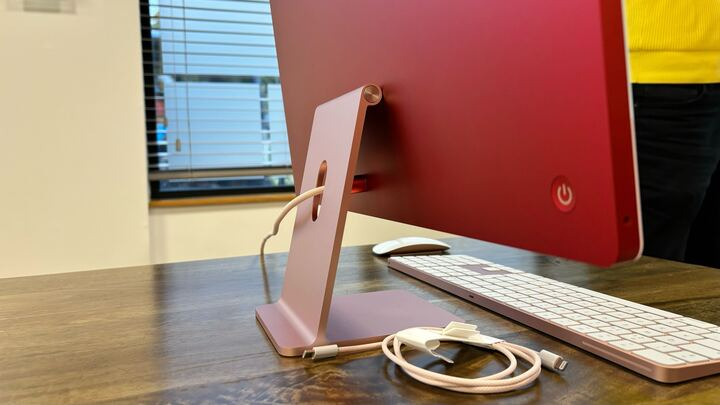
The Apple iMac 24-inch (M3) keeps the same design as the M1 model from two years ago, and that’s both a good and bad thing. On the plus side, it remains an attractive and stylish all-in-one, and the 2021 redesign did a great job of updating the aesthetics to make it feel more modern.
This means thinner bezels around the screen, so less overall space is taken up, and the angular-yet-rounded corners bring to mind modern iPhones such as the iPhone 15 range. Thanks to the size and efficiency of the M3 chip (which uses the 3nm process, allowing for an incredibly small chip), the body behind the screen is impressively thin. There’s no chunky parts or big whirring fans that kick in when in use here, as with many other all-in-ones that have to balance a relatively compact form factor with making sure the components inside don’t overheat.
The only concession to the hardware included in the iMac is with the thicker bottom bezel, which is where the bulk of the components are placed.
The 24-inch screen is again the same as the last model: it has a 4.5K Retina resolution which supports the P3 wide color gamut and over a billion colors, and 500 nits of brightness. It also features a 1080p FaceTime camera and 'studio-quality' microphones, plus a six-speaker setup for spatial audio. The screen is held by a base and arm that feel sturdy but allow it to be easily tilted and positioned.
Perhaps the best thing about the 2021 redesign also returns: the varied colors in which you can buy the iMac. You have a choice of seven: green, pink, blue, silver, yellow, orange and purple, and the cables and accessories that come with the iMac reflect the color you choose. However, bear in mind that only the first four of those colors are available on the base-level model.
It was lovely seeing Apple bring a bit of color back to its Macs, serving as a nod to its past with the colorful iMac G3, as well as a break with current style of PCs and laptops generally coming in variations of gray and black.
As with the previous model, the colors give it a sense of personality that other all-in-ones lack, but thanks to their muted, pastel, hues, they look stylish rather than childish. They’d fit into any modern home, office or studio without much issue. Apple sent TechRadar the iMac in pink, and it really looks lovely. The fact that the peripherals and braided cables also come in the same color is a great touch that has been carried over from the 2021 model.

With dimensions of 54.7 x 46.1 x 14.7cm (21.5 x 18.1 x 5.8-inches) and a weight of 4.48kg (9.75lbs), the Apple iMac 24-inch (M3) doesn’t take up much space on a desk, and is relatively easy to pick up and place where you need. Thanks to the all-in-one form factor, which combines the screen and computer in one connected device, it’s far less hassle to set up and move than a standard desktop PC which requires various cables and a separate monitor.
The included Magic Mouse and Magic Keyboard (plus the Magic Trackpad if you pay extra), are wireless, again minimising the clutter on your desk, and come charged and paired with the iMac, so you can take them out and start using them straight away. It’s a nice bit of Apple’s ‘it just works’ philosophy, and while it might not sound like a big deal, some Windows-based all-in-ones come with peripherals which need to be initially paired or charged, which makes the setup process less simple.
However, as I said, by sticking with the same design as the 2021 model, there are some frustrations as well, and it’s perhaps most apparent with the peripherals. When rumors of a new iMac started swirling, many people (myself included) had hoped that Apple would use this new model as an excuse to give the peripherals a design tweak.
This is mainly because they still use a USB to Lightning connection, which feels out of place considering that Apple has finally (and begrudgingly) swapped its proprietary Lightning port in its new iPhone 15 range for the much more widely-used USB-C. Back when iPhones (and other Apple devices) still used Lightning, it sort of made sense for the iMac peripherals to use it as well, as it meant you could use an iPhone charger to charge the peripherals – and vice versa. However, there will become a time when that’s no longer possible, and with pretty much every wireless mouse or wireless keyboard coming with USB-C ports, the fact Apple didn’t include them with the Magic Mouse and Magic Keyboard feels like a wasted opportunity – and a rather dated decision.
What’s more frustrating, in my opinion at least, is that this also means that the charging port of the Magic Mouse remains on the bottom of the mouse. Apple’s argument is that by having it there, rather than on the front or back of the mouse, like pretty much every other wireless mouse in existence, it has a sleeker design. However, the downside is that when you need to charge the mouse, you simply cannot use it due to the wire sticking out of the bottom.
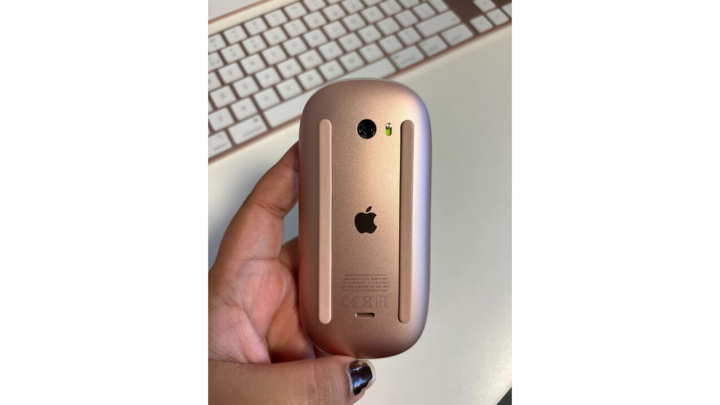
It’s a baffling design decision from a company that usually nails the form and function of its devices, and the fact that Apple still clings on to this choice is even stranger, and feels a bit like stubbornness. Sometimes you do something in a different way from everyone else because you’re innovating – but other times it’s because you’re wrong.
The lack of a new design means that you’re stuck with 24 inches, which will be a blow to people hoping to finally see an Apple silicon-powered 27-inch iMac. Also, 24 inches no longer feels like a particularly large screen size, especially for creatives looking for a device to work on their footage and images.
Of course, you can plug in a larger external USB-C monitor, but that kind of defeats the point of having an all-in-one device.
The front of the iMac is free from buttons and ports, and on the back you get the power button, along with two Thunderbolt USB 4 ports on the base model. If you go for a more expensive model, you also get two additional USB 3 ports next to the others. This can lead to a bit of confusion, as all four ports use the USB-C interface, but two of them are slower, maxing out at 10Gb/s, rather than 40Gb/s of the USB 4 ports.
The two faster ports are identified by a small lightning bolt icon above them, but because the ports are at the back of the screen, and are the exact same shape, it makes it very hard to distinguish between them. For peripherals this won’t be an issue – they’ll work the same – but if you plug in a storage device, such as an external SSD, you’ll see a big impact on file transfer speeds depending on which port you plug it into.
Overall, then, the design of the Apple iMac 24-inch (M3) provides a welcome return of a stylish redesign, along with a less welcome return of some less successful design decisions.
- Design score: 4/ 5
Apple iMac 24-inch (M3) review: Performance
- New M3 chip is big step up from M1
The new iMac 24-inch launched alongside new MacBook Pros showcasing Apple’s latest M3 series of chips, and while the all-in-one doesn’t come with the more powerful M3 Pro and M3 Max variants, which are currently exclusive to the new MacBook Pro 14-inch (M3) and MacBook Pro 16-inch (M3) models, those two higher-end chips are going to be overkill for most regular users.
The base M3 chip is still a significant upgrade over the previous iMac’s M1 chip (Apple didn’t release an M2 version of its all-in-one), and an even bigger leap over the Intel processors found in older iMacs. That makes the new iMac a far more justifiable upgrade than the two new MacBook Pros, which are replacing M2 Pro and M2 Max versions that launched only 10 months ago.
Here's how the Apple iMac 24-inch (M3) performed in our suite of benchmark tests:
3DMark: Wildlife Extreme: 7,993
GeekBench 6: 3,010 (single-core); 12,039 (multi-core)
Cinebench R23: 1,897 (single-core); 9,943 (multi-core)
Cinebench R24: 140 (single-core); 651 (multi-core)
Handbrake 1.6: 44fps
Sid Meier's Civilization VI: Gathering Storm: 39fps
Apple claims that the M3 chip is up to 35% faster than the Apple M1 chip, and you can configure the new iMac with up to 24GB of unified memory – whereas the M1 model maxed out at 16GB. For multitasking and more intensive workloads, this is going to be very welcome.
The base iMac (M3) comes with an 8-core CPU and 8-core GPU, compared to the 8-core CPU and 7-core GPU of the base M1 model, and you can also upgrade the M3 to have an 8-core CPU and 10-core GPU (whereas the M1 model could only be upgraded to an 8-core CPU and 8-core GPU).
The model Apple sent in for us to review is the highest-end version, with the 8-core CPU and 10-core GPU M3 and 24GB memory, plus 2TB of storage, so the kind of performance I experienced with it during my time using and reviewing the new iMac may not quite match yours if you go for a more affordable model (though the difference shouldn’t be that extreme).
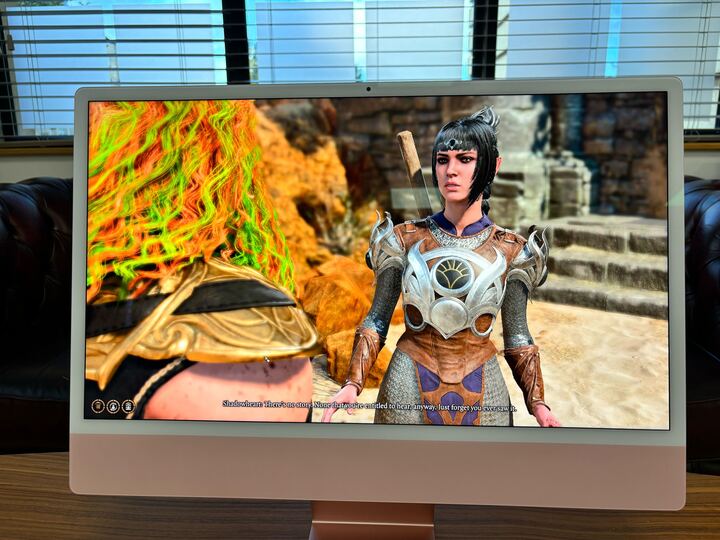
When it comes to our benchmark tests, Apple’s claims about the M3’s impressive performance certainly hold up. In the Cinebench R23 CPU tests, which look at how well the chip’s processor performs, the new iMac with M3 scored 1,897 in single core tests, and 9,796 in multicore tests. This is a big leap over the iMac with M1’s scores, which hit 1,489 and 7,754 respectively in the same tests.
In Geekbench 5, which again puts the CPU part of the chip to the test, the new iMac scored 2,284 in single-core tests, and 10,716 in multi-core tests, compared to the previous iMac’s scores of 1,725 and 7,650.
These scores show a clear leap in CPU performance, and while the M1 iMac was no slouch when it first launched, I was immediately impressed with how fast and fluid the new M3 iMac felt when using macOS Sonoma. Even with multiple open Chrome tabs and numerous apps running, the iMac 24-inch (M3) was ultra-smooth in use.
Interestingly, the single-core scores for the M3 in both Cinebench R23 and Geekbench 5 actually beat those for the M1 Max, which was once the flagship chip from Apple. While the M1 Max overtook the M3 in multi-core tests, due to having more cores, this is a great example of how quickly Apple silicon is evolving, and while the new iMac doesn’t have M3 Pro or M3 Max configurations, it’s a formidable performer, and few – if any – all-in-one PCs can match it.
When it comes to graphics performance, the M3 (which is what’s known as a System on Chip, and which features a CPU, GPU and memory all on the same chip) also impresses. At the launch event, Apple made a big deal about the new graphical prowess of the M3 family, with hardware-accelerated ray tracing now included – something even some dedicated gaming laptops lack.
There’s also Dynamic Caching that makes use of the fast unified memory included on the M3, and mesh shading for geometry processing in complex 3D scenes.
These improvements mean workflows are seriously sped up compared to the previous-generation iMac, as evidenced by our Handbrake video encoding tests, and for the first time ever, the iMac is also a viable gaming device.
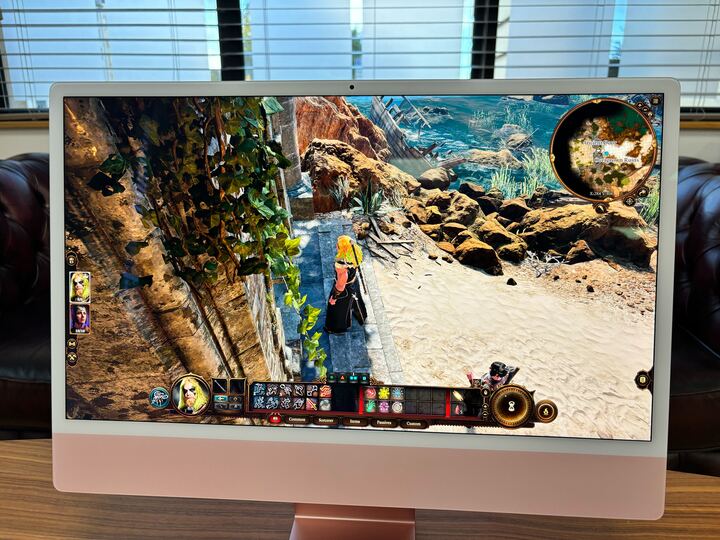
Playing Lies of P, a graphically intensive game where timing is everything, the iMac with M3 scored on average 33fps (Frames Per Second) – an impressively playable experience. Shadow of the Tomb Raider also ran well at 36fps, and Total War: Warhammer III, which is quite CPU-intensive due to its complex battles featuring a multitude of units, scored 38.4fps.
While these scores aren’t going to make PC gamers with RTX 4090-equipped rigs consider switching, it’s an impressive result for a thin all-in-one PC with integrated graphics. The six-built in speakers get a good workout during games, and music via Apple Music and YouTube sounds fantastic, again impressive due to the thin design of the iMac 24-inch, which limits the kind of speakers you can include. Thanks to macOS Sonoma’s new Game Mode, the iMac also cleverly detects when you’re playing a game and ensures resources are allocated to keep the game running smoothly, while lowering the latency of wireless peripherals such as the PS5 DualSense controller, or AirPods earphones.
One thing to note is that these results were for games running at 1080p. They looked fantastic on the iMac’s screen, but they don’t make use of its native resolution of 4.5K (4,480 x 2,520). At that resolution, the M3’s GPU really struggles. Shadow of the Tomb Raider, for example, drops to just 6fps at native resolution – making it resemble a slideshow more than a game.
Despite not coming with the high-end M3 Pro or M3 Ultra, the iMac 24-inch (M3) is an excellent performer, outclassing any Windows-based all-in-one at this price point, and represents a very good leap over the previous M1 model as well. Thanks to the efficiency of the M3 chip, along with a clever thermal solution, I didn’t notice any performance throttling while using it, even when testing out 4K video editing in Adobe Premier Pro, and the fans didn’t kick in either, so the iMac was essentially silent in use as well.
- Design score: 4.5/ 5
Should you buy the Apple iMac 24-inch (M3)?
| Attributes | Notes | Rating |
|---|---|---|
| Value | A price bump for the base model is a shame, but you still get a lot for your money | 3 / 5 |
| Design | Same iconic design as previous model. Looks great, but some niggles remain | 4 / 5 |
| Performance | The M3 chip turns the new iMac into a formidable computer which can also play the odd game | 4.5 / 5 |
Buy it if...
You want the best all-in-one PC
Yet again, the iMac 24-inch (M3) proves that Apple leads the pack when it comes to all-in-one PCs.
You have limited space
The thin design and modest screen size means the iMac 24-inch (M3) can be easily set up in almost any room in a home or office.
You enjoy the occasional game
The graphical advancements of the M3 chip, along with macOS Sonoma’s Game Mode, means that playing games on the iMac isn’t just possible – it’s enjoyable as well.
Don't buy it if...
You want a big screen
The 24-inch screen makes the new iMac easy to carry and place, but if you want more screen real estate, you should look elsewhere.
You want high-end Apple silicon
The lack of M3 Pro or M3 Max options means you’ll need to get a new MacBook for the ultimate performance from this generation of Apple silicon.
You’re a hardcore gamer
The new iMac is an exciting step forward for the viability of gaming on Macs, but don’t go thinking this will give the likes of Alienware or Razer a run for their money.
How I tested the iMac 24-inch (M3)
- Spent several days testing and using the iMac
- Ran our suite of benchmark tests
- Played several games
As soon as the iMac 24-inch landed in the office, I set it up and began testing. This involved using it for day-to-day tasks, such as writing up articles in Google Docs and sending emails, as well as browsing the web in both Chrome and Safari (with multiple tabs open).
I also played several games, including Lies of P and Total War: Warhammer III to test out Apple’s claims about the M3 chip’s gaming performance. With the help of my colleague John Loeffler, we ran our usual suite of benchmarks over the weekend as well, so I could get a full idea of just how well the new iMac performs.
I’ve tested several iMacs in the past for TechRadar, including the previous model with the M1 chip, as well as the iMac Pro and 27-inch Intel-based iMacs, so I compared my experience of those devices, as well as many Windows-based all-in-one PCs, to inform this review.
First reviewed November 2023

Matt is TechRadar's Managing Editor for Core Tech, looking after computing and mobile technology. Having written for a number of publications such as PC Plus, PC Format, T3 and Linux Format, there's no aspect of technology that Matt isn't passionate about, especially computing and PC gaming. He’s personally reviewed and used most of the laptops in our best laptops guide - and since joining TechRadar in 2014, he's reviewed over 250 laptops and computing accessories personally.
